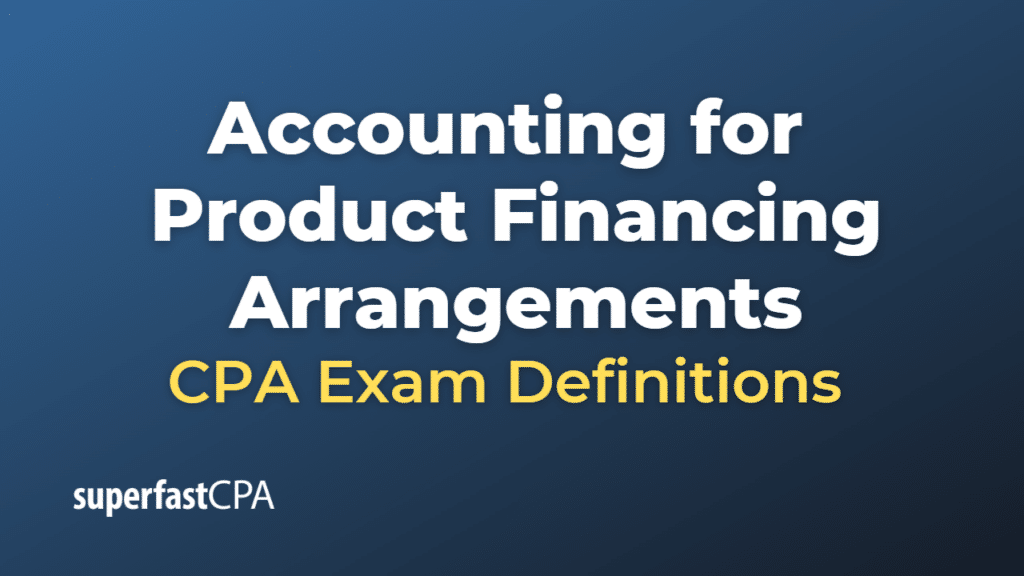Accounting for Product Financing Arrangements
Accounting for product financing arrangements involves the identification, recognition, measurement, and disclosure of transactions where a company (the seller) sells its products to a financing entity and simultaneously enters into an agreement to repurchase those products or similar products at a later date. These arrangements are also known as buy-sell arrangements or off-balance-sheet financing.
Under U.S. Generally Accepted Accounting Principles (GAAP), accounting for product financing arrangements is primarily governed by the Financial Accounting Standards Board (FASB) Accounting Standards Codification (ASC) Topic 470-40, “Product Financing Arrangements.
Here are the key aspects of accounting for product financing arrangements:
- Identification: Determine if a transaction qualifies as a product financing arrangement. This typically involves assessing the contractual terms, the transfer of risks and rewards, and the seller’s continuing involvement with the products.
- Recognition and measurement: If the transaction qualifies as a product financing arrangement, the seller should not recognize the sale of the product to the financing entity as revenue. Instead, the seller should record a financing obligation equal to the proceeds received from the financing entity.
- Repurchase: When the seller repurchases the products, it should reduce the financing obligation by the amount paid to the financing entity and adjust the carrying amount of the repurchased products to their original cost basis.
- Interest expense: The seller should recognize interest expense on the financing obligation over the term of the arrangement, using the effective interest method. The interest expense should be based on the interest rate implicit in the arrangement, considering the total payments required under the arrangement and the proceeds received from the financing entity.
- Disclosure: Disclose information about the product financing arrangements, such as the nature of the arrangements, the financing obligations, the interest expense, and any risks and uncertainties related to the arrangements in the notes to the financial statements.
By properly accounting for product financing arrangements, a company provides users of its financial statements with an accurate representation of its financial position and performance, considering the financing obligations, the related interest expense, and any associated risks and rewards.
Example of Accounting for Product Financing Arrangements
Let’s consider an example of a company accounting for a product financing arrangement.
Example: Company XYZ manufactures electronic devices and needs to raise short-term cash. It enters into a product financing arrangement with a financing entity, Bank ABC. Company XYZ sells $1,000,000 worth of electronic devices to Bank ABC and agrees to repurchase the same or similar devices for $1,030,000 in six months. The implicit interest rate in the arrangement is 6%.
Here’s how Company XYZ would account for the product financing arrangement:
Step 1:
Identification: The transaction qualifies as a product financing arrangement because Company XYZ sells the products to Bank ABC and simultaneously enters into an agreement to repurchase the products at a later date.
Step 2:
Recognition and measurement: Company XYZ does not recognize the sale of the electronic devices as revenue. Instead, it records a financing obligation equal to the proceeds received from Bank ABC.
| Financing obligation: $1,000,000 |
Step 3:
Interest expense: Company XYZ calculates the interest expense on the financing obligation using the implicit interest rate of 6% over the six-month term.
| Interest expense: $1,000,000 × 0.06 × (6 months / 12 months) = $30,000 |
Step 4:
Financial statement impact:
- The financing obligation of $1,000,000 is reported as a liability in the balance sheet.
- The interest expense of $30,000 is recognized in the income statement, which reduces the company’s net income.
Step 5:
Repurchase: When Company XYZ repurchases the electronic devices for $1,030,000, it reduces the financing obligation by the amount paid to Bank ABC and adjusts the carrying amount of the repurchased products to their original cost basis.
| Financing obligation (initial): | $1,000,000 |
| Less: Repurchase amount: | $1,030,000 |
| Financing obligation (end): | $0 |
Step 6:
Disclosure: Company XYZ discloses information about the product financing arrangement, the financing obligation, the interest expense, and any risks and uncertainties related to the arrangement in the notes to the financial statements.
By properly accounting for the product financing arrangement, Company XYZ provides users of its financial statements with an accurate representation of its financial position and performance, considering the financing obligation, the related interest expense, and any associated risks and rewards.













